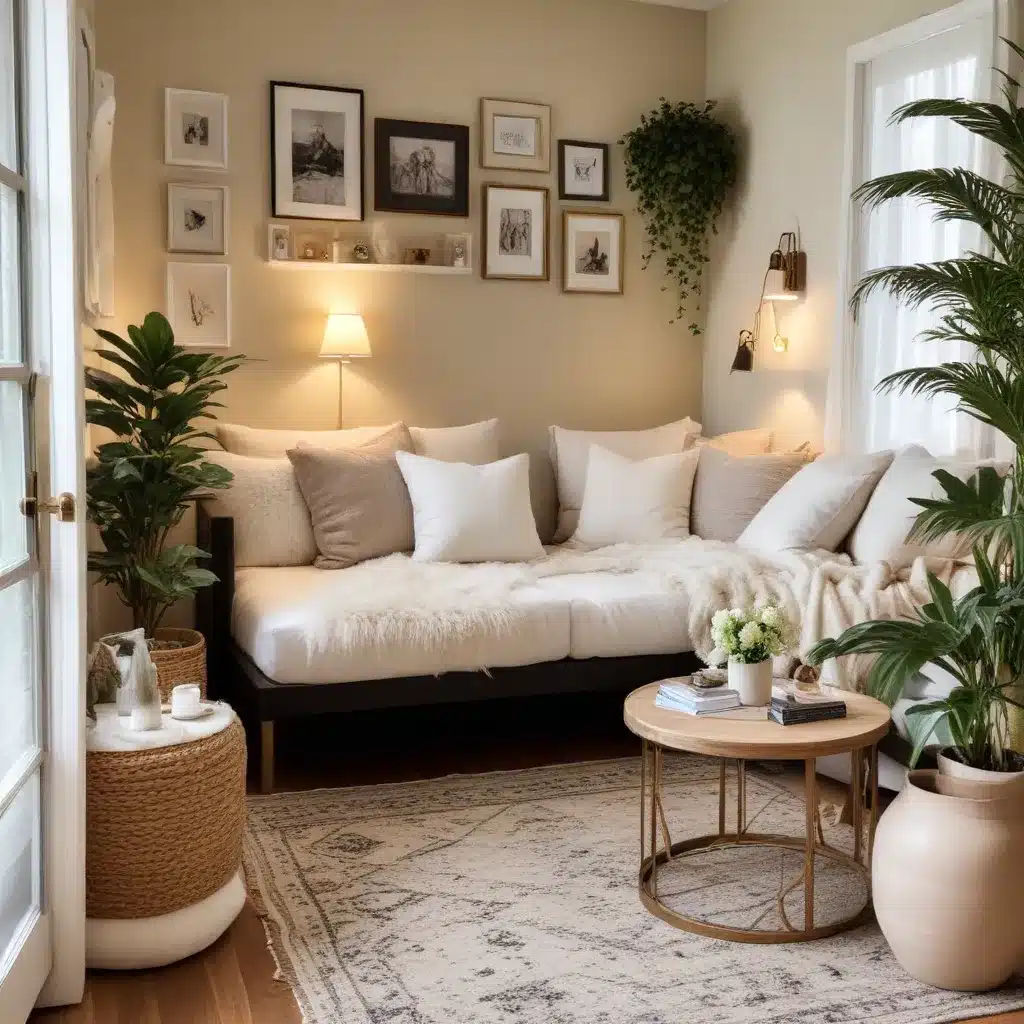
As an experienced home improvement consultant, I’ve seen firsthand how challenging it can be to transform a cramped or uninspiring small space into a cozy, stylish retreat. However, with the right approach and a few strategic design moves, even the most modest of rooms can be converted into a comfortable oasis that feels like a true extension of your living space. In this comprehensive guide, we’ll explore the key elements required to craft a chic and inviting small-space design, covering everything from textural layering and multifunctional furniture to eco-friendly solutions and personalized touches.
Designing for Comfort
The foundation of any cozy small-space design begins with thoughtful attention to comfort. After all, what’s the point of creating a stylish sanctuary if it doesn’t feel inviting and relaxing to inhabit? One of the most effective ways to cultivate a sense of coziness is through the strategic use of textural elements.
Incorporating a variety of textures – from plush throw pillows and fuzzy blankets to woven baskets and natural wood accents – helps to add visual interest and a tactile quality that encourages visitors to sink in and unwind. When selecting textiles, opt for high-quality, durable outdoor fabrics that can withstand the elements if your small space is an exterior patio or balcony.
Equally important is the selection of comfortable furniture. Forgo rigid, uninviting pieces in favor of plush, generously-sized sofas and deep, cushioned armchairs that invite lingering. If space is truly at a premium, consider a daybed or chaise lounge – these versatile items can serve as both a seating option and a cozy spot for napping or reading.
Thoughtful lighting strategies can also play a crucial role in cultivating a cozy ambiance. Incorporate a mix of ambient lighting from floor or table lamps, task lighting for reading or work areas, and accent lighting such as string lights or lanterns to create a warm, inviting glow. Remember to position lights strategically to avoid harsh shadows or uneven illumination in your small space.
Maximizing Space
One of the biggest challenges of small-space design is making the most of every square inch. Fortunately, there are plenty of clever tricks and multifunctional furniture solutions to help you accomplish this goal.
When it comes to storage, think vertically – wall-mounted shelves, hanging planters, and tall bookcases or cabinets can all help to maximize your available floor space. Invest in ottomans or benches with hidden storage compartments to tuck away extra linens, toys, or media accessories.
For seating, look for pieces that serve double duty, such as a daybed that can transform into a guest bed or a sectional sofa with built-in chaise lounges. Nesting tables and expandable console tables offer flexible surface space that can be configured to suit your needs.
If your small space includes an oddly-shaped nook or a tricky corner, consider designing a custom built-in unit that seamlessly integrates storage, display, and seating. This not only makes the most of your available square footage but also creates a cohesive, intentional look.
Finally, don’t be afraid to use mirrors strategically to create the illusion of openness and depth in your small space. Placing a large mirror across from a window or opposite a seating area can help to reflect light and make the room feel more spacious.
Achieving Chic Aesthetics
While comfort and functionality are crucial, it’s equally important to cultivate a visually appealing small-space design that reflects your personal style. Start by establishing a cohesive color palette and sticking to it throughout the room – this will help to create a sense of visual harmony and prevent the space from feeling cluttered or disjointed.
When it comes to decor placement, be intentional. Resist the urge to cram every available surface with trinkets and knickknacks, which can quickly make a small space feel overwhelmed. Instead, thoughtfully curate your accessories, focusing on a few meaningful pieces that add visual interest without overwhelming the eye.
Embrace a minimalist approach to furniture and decor, opting for sleek, streamlined silhouettes that don’t visually “weigh down” the room. Complement this aesthetic with clean-lined lighting fixtures, uncluttered shelving, and simple window treatments that allow natural light to flood the space.
Personalized Touches
While adhering to a cohesive design scheme is important, don’t forget to infuse your small space with personal touches that make it feel truly unique and reflective of your individual style. Incorporate meaningful artwork, family photos, or treasured mementos to create a warm, lived-in feel.
Bringing in natural elements such as potted plants, fresh flowers, or driftwood accents can also help to soften the overall aesthetic and connect your small space to the great outdoors. If you’re short on floor space, consider hanging planters or wall-mounted terrariums to introduce lush greenery without sacrificing precious square footage.
Finally, don’t be afraid to experiment with unconventional decor pieces that spark joy or inspire creativity. Whether it’s a vintage typewriter, a whimsical wall-hanging, or a one-of-a-kind thrifted find, these personalized touches can help to make your small space feel like a true reflection of your personality.
By following these principles of comfort, functionality, cohesive aesthetics, and personalized flair, you can transform even the most modest of small spaces into a cozy oasis that you’ll be eager to retreat to, day after day. For more inspiring small-space renovation ideas, be sure to visit Reluctant Renovator – your go-to resource for all things home improvement.



